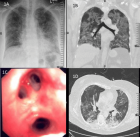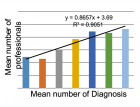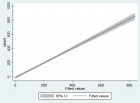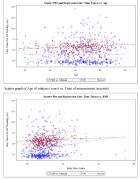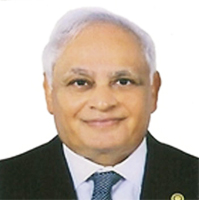About Shahid Beheshti University of Medical Sciences
Shahid Beheshti University of Medical Sciences
Articles by Shahid Beheshti University of Medical Sciences
Parry-Romberg syndrome: A case report of non-invasive treatment
Published on: 30th December, 2019
OCLC Number/Unique Identifier: 8507799816
Parry-Romberg syndrome is an uncommon condition, self-limiting with slow progressive hemifacial atrophy. This syndrome can lead to several progressive congenital and developmental deformities. It can cause severe facial asymmetry and subsequently lead to esthetic and psychological problems and adversely affect patient’s quality of life, so its treatment holds great importance. Still, there is no exact treatment protocol for this disease, treatment approaches are bounded and patient’s response to the treatment is imponderable. However, most of the patients can benefit from conservative treatments. In this paper, we have reported a moderate case of Parry-Romberg syndrome, with no familial history of any syndromes. We also have discussed about present anomalies and the steps of exerted conservative treatments.
Epidemiologic aspects and risk factors associated with infertility in women undergoing assisted reproductive technology (ART) in north of Iran
Published on: 20th January, 2021
OCLC Number/Unique Identifier: 8897953759
Objective: This study aimed to investigating of the epidemiological aspects of infertility and related risk factors in infertile women.
Materials and methods: This cross-sectional study, carried out on 330 infertile women referred to two infertility treatment center of Imam Khomeini Hospital and Mother center in Sari, Iran, from April 2015 to March 2017.
Results: 54.5% of these women were in the age of 30-39 years, infertility duration in 55.2% was 1-5 years, Body mass index (BMI) in 44.5% of samples was 26-30 kg/m2, 54.5% had diploma and associate degree. 63.6% lived in urban areas. 74.5 % of patients reported primary infertility. History of polycystic ovarian syndrome (PCOs) and pelvic inflammatory disease (PID) and poor ovarian reserve were the most common causes and risk factors for the infertility with prevalence 19.42%, 16.81% and 13.91%, respectively. Most underlying disease was thyroid disorders (54.5%). There was found statistically significant relationship between residents of urban areas and infertility duration, endometriosis and educational levels, miscarriage with thyroid. Data analysis performed using IBM SPSS 21 software and Chi-Square test (p < 0.05).
Conclusion: The results showed that women with infertility in north of Iran were more likely to be older, less educated, and also had overweight. They are more possible to have ovarian disorders. In these area, thyroid disease more common like Iodine deficient regions. Future research should be focused on the reasons why majority of women don’t seek treatment for the underline significant diseases that may be effects on ovarian function and fertility.
Iodine status and thyroid parameters of pregnant women living in an iodine sufficient area
Published on: 3rd February, 2021
OCLC Number/Unique Identifier: 8980371650
During the last few decades painstaking efforts have been made to eliminate iodine deficiency throughout the world. Todays in regions where dietary iodine intake is adequate or borderline, the main focus is increasing dietary iodine supply in the target population during pregnancy and the first years of life.
Objective: The aim of this study was to obtain longitudinal data on urinary iodine excretion and the changes of maternal thyroid parameters in two groups of healthy women with mild-to-moderate iodine deficiency and iodine sufficiency residing in an iodine replete area of Tehran capital city of IR Iran, for more than one decade.
Research designs and methods: The present study is part of a cohort study, investigating the relative influences of iodine intake on thyroid size and function of mothers and their infants during and after pregnancy. A total of 500 pregnant women enrolled from two mother-child health care centers and was divided into group I, with median urinary iodine excretion (MUIE) < 150 µg/L, and group II with MUIE ≥ 150 µg/L. Sonographic thyroid volume measurement, urinary iodine excretion and thyroid function tests were measured sequentially in all pregnant women during the three trimesters (T) of pregnancy.
Results: The mean ± SD age of the participants was 25.1 ± 5.1 years. The MUIE in group I and II in the first, second and third trimester were 123 and 250 µg/L, 127 and 166 µg/L, 120 and 150 µg/L, respectively. The MUIE in the third trimester of pregnancy in group I did not differ significantly from the values in the first and second trimesters (p = 0.67), but it did decline significantly in group II (p < 0.001). The median thyroid volume of subjects, in the first, second and third trimesters were 7.8, 8.2 and 8.1 ml in group I and 7.5, 8.0 and 8.4 ml in group II, respectively. No difference in thyroid volume was found between two groups in each of the three trimesters of pregnancy (p > 0.05). The mean (± SD) TSH concentration of subjects in first, second and third trimester was 2.3(± 2.6), 2.1(± 1.8), 2.3(± 1.7) mIU/L in group I and 2.1(± 3.1), 2.1(± 1.8) and 2.0(± 1.3) mIU/L in group II, respectively. The trend of TSH rising in group I was 26.7% and in group II it was 13.3%. The mean TSH value in three trimesters did not differ significantly in either groups (p > 0.05). The mean (± SD) total T4 concentrations of subjects in first, second and third trimesters were 13.2(± 3.4), 13.8(± 3.3), 13.0(± 2.9) µg/dl in group I and 13.1(± 3.2), 13.7(± 2.9), 13.4(± 3.2) µg/dl in group II, respectively. The mean total T4 value in three trimesters did not differ significantly in either groups (p > 0.05). There was no correlation between the thyroid volume and three observed parameters (UIE, total T4 and TSH) during the pregnancy in either groups.
Conclusion: Even in areas with well-established universal salt iodization program, pregnancy could be a risk of having iodine deficiency and systematic dietary fortification needs to be implemented in this vulnerable group.
Mild to moderate iodine deficiency in pregnancy: A matter of debate
Published on: 12th March, 2021
OCLC Number/Unique Identifier: 8980359493
During the last few decades painstaking efforts have been made to eliminate iodine deficiency through the world. Nowadays in regions where dietary iodine intake is adequate or borderline, the main focus is increasing dietary iodine supply in the target population during pregnancy and the first years of life. Severe iodine deficiency during pregnancy increases the risk of irreversible brain damage, intellectual disability, neurologic abnormalities, stunted growth, increased pregnancy loss, infant mortality, impairments in child development and cretinism. The potential effects of mild-to-moderate iodine deficiency are debated. Results from animal studies and observational human studies indicate that maternal mild-to-moderate iodine deficiency disturbs thyroid function in pregnancy and it also may affects fetal neurodevelopment. The effect of supplementation of iodine on thyroid function of pregnant women and their newborn, neurodevelopment of infants and cognitive performance of children have been investigated using iodine nutrition in pregnancy, based on median urinary iodine concentration. However they have found conflicting results regarding the benefits or harms of iodine supplementation in pregnancy. Although many epidemiological, interventional and clinical studies have supported the association between thyroid function in pregnant women and later psychomotor and mental development of their children, the effect of iodine supplementation in pregnant women on neurodevelopment of children is inconclusive. Even in areas with well-established universal salt iodization program, pregnancy could be at risk of having iodine deficiency and despite WHO/ICCIDD/UNICEF recommendation which believe that dietary iodine fortification during pregnancy depends primarily on the extent of pre-existing iodine deprivation, systematic dietary fortification needs to be implemented in this vulnerable group. However, iodine supplementation of mildly iodine deficient pregnant women may not have beneficial effects in their thyroid function or neurodevelopment of their children.
Critical Management of Status Epilepticus
Published on: 14th March, 2017
OCLC Number/Unique Identifier: 7317652597
Seizure is clinical manifestation of sudden disruption of the normal electrical activity of cortical neurons. The brain electrical activity is periodically disturbed, alteration in neural cell integrity, increase in firing impulses and spread to adjacent normal neurons result in temporary brain dysfunction with alterations in consciousness, behavior or motor function. It may be triggered by illness, infection, stress, stroke, brain tumor, or the underlying cause may not completely understand. Status epilepticus (SE) is a medical emergency and requires prompt diagnosis and treatment. Treatment includes general support measures, drugs to suppress epileptic activity and relieving the underlying condition. Refractory SE requires admission to an intensive care unit (ICU) to allow adequate monitoring and support of respiratory, metabolic and hemodynamic functions and cerebral electrical activity. For SE treatment, benzodiazepines are the first line antiepileptic agents, and if benzodiazepines fail to control seizures, Phenytoin is usually indicated; Phenobarbital or Valproate may also be considered. For refractory SE, Propofol and Thiopental represent first line agents after careful assessment of potential risks. In refractory SE, general anesthesia may be required. There is currently no unique consensus for definite treatment option of RSE. In this review, the management protocol of seizure, assessment, monitoring, and different alternative therapy would be discussed.
A Three approach at one stage to surgical management of Cervical Spondyloptosis after Failed Primary anterior fusion
Published on: 31st December, 2018
OCLC Number/Unique Identifier: 7970377562
A 35-year-old female, known case of complete spinal cord injury, presented with cervical pain and neck deformity that interfere with her physiotherapy and occupational therapy. Two years before admission, she had a car accident which result in a complete quadriplegia. That time at another center, she underwent surgery to anterior cervical fixation of C6-C7 through insertion of cage and plate without corpectomy. Based on current radiologic images, spondyloptosis was detected at the C6-C7 with bilateral locked facet, due to hardware failure. A three approaches in one stage was performed to maintain cervical alignment that includes posterior, anterior and again posterior approach. With this manner, anterior fusion through corpectomy and insertion of expandable cage and plate as same as instrumental posterolateral fusion were done. After surgery, she was pain free and the alignment of cervical spine was maintained so she could come back to ordinary rehabilitation programs.
Investigation of snow load reduction in the industrial sheds roof design with photovoltaic systems by mathematical modelling, solar system evaluation, X-steel simulation and thermodynamic practices
Published on: 8th September, 2021
OCLC Number/Unique Identifier: 9244772554
Since snow load is one of the loads of designing the industrial shed roof, this research presents a new system to reduce the industrial sheds roof design. In this system, sensitive units of moisture and temperature, which can be adjusted with different areas, are installed on the shed’s roof. The mechanism of system is that the sensors in the units detect the presence of snow on the shed roof and send an order to connect electricity to the elements; therefore, the snow on the roof melts by the heat generated. In this system, solar panels are used to supply electricity. As with the help of this mechanism, snow does not remain on the roof, it is possible to eliminate the snow load in the calculations of the shed and apply at least the live load of the sixth regulation (Due to having a one-story shed, minimum live load applied and it used only for the foundation design of the structure.), this issue will create an economic plan in shed designing. According to the study conducted in this research, it is shown that the dimensions of the sheet beam used in the shed are reduced, which will significantly reduce the cost of construction and installation to some extent. In the following, two samples of sheds with a span of 20 meters in the presence of snow and the absence of snow in the software were modelled, and the results were compared with each other.

If you are already a member of our network and need to keep track of any developments regarding a question you have already submitted, click "take me to my Query."









